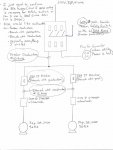Davisteam
Member
- Location
- Granite City, IL
Hi, I have a Lift station with 2, 3hp, 240vac, 3 phase pumps.
I need to replace the 60A Fused, 3-pole, double-throw, safety switch with 6, 60A fuses, which feeds two 20A IT breakers. Each of these breakers feeds a size 0 motor starter with overload protection. I have added a drawing of what I have as an attachment. I just need someone to check my calculations to make sure I am upgrading to code.
Thank You,
Mike
I need to replace the 60A Fused, 3-pole, double-throw, safety switch with 6, 60A fuses, which feeds two 20A IT breakers. Each of these breakers feeds a size 0 motor starter with overload protection. I have added a drawing of what I have as an attachment. I just need someone to check my calculations to make sure I am upgrading to code.
Thank You,
Mike


